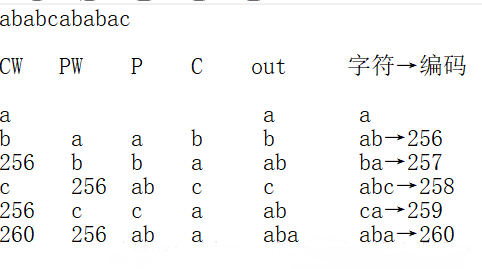java压缩与解压 Java压缩之LZW算法字典压缩与解压讲解
凌晨两点半的太阳v 人气:0压缩过程:
前面已经写过一篇哈夫曼压缩,LZW字典压缩与哈夫曼压缩的不同之处在于不需要把编码写入文件,编码表是在读文件中生成的,首先将0-255个ASCLL码与对应的数字存入哈希表中,作为基础码表。

这里的后缀为当前
前缀+后缀 如果在码表中存在,前缀等于前缀+后缀。如果不存在,将前缀+后缀所表示的字符串写入编码表编码,同时将前缀写入压缩文件中。这里重点注意一下,一个字节所能表示的数字范围为0-255,所以我们将一个字符的编码变成两个字节写进去,分别写入它的高八位和低八位,比如256即为00000001 11111111 这里用到DataOutputStream dos对象中的 dos.writeChar(256)方法。
两个字节所能表示的范围为0-65535。当我们的编码超过这份范围,就需要重置编码表,再重新编码。
解压过程

CW表示读取的到的字符,PW为上一行的CW,CW再编码表中存在:P→PW,C→CW的第一个字符,输出CW。CW在编码表中不存在,P→PW,C→PW的第一字符输出P+C。
当我们读到65535的时候,就重置码表,重新编码。
代码部分
public class Yasuo {
private int bianma = 256;// 编码
private String perfix = "";// 前缀
private String suffix = "";// 后缀
private String zhongjian = "";// 中间变量
HashMap<String, Integer> hm = new HashMap<String, Integer>();// 编码表
private static String path = "D:\\JAVA\\字典压缩\\zidianyasuo.txt";// 要压缩的文件
private static String path2 = "D:\\JAVA\\字典压缩\\yasuo.txt";// 解压后的文件
private static String path3 = "D:\\JAVA\\字典压缩\\jieya.txt";// 解压后的文件
public static void main(String[] args) throws IOException {
/**
* 压缩
*/
Yasuo yasuo = new Yasuo();
yasuo.yasuo();
/**
* 解压
*/
Jieya jie = new Jieya();
jie.jieya(path2,path3);
}
public void yasuo() throws IOException {
// 创建文件输入流
InputStream is = new FileInputStream(path);
byte[] buffer = new byte[is.available()];// 创建缓存区域
is.read(buffer);// 读入所有的文件字节
String str = new String(buffer);// 对字节进行处理
is.close(); // 关闭流
// 创建文件输出流
OutputStream os = new FileOutputStream(path2);
DataOutputStream dos = new DataOutputStream(os);
// System.out.println(str);
// 把最基本的256个Ascll码放编码表中
for (int i = 0; i < 256; i++) {
char ch = (char) i;
String st = ch + "";
hm.put(st, i);
}
for (int i = 0; i < str.length(); i++) {
if(bianma==65535){
System.out.println("重置");
dos.writeChar(65535);//写出一个-1作为重置的表示与码表的打印
hm.clear();//清空Hashmap
for (int j = 0; j < 256; j++) {//重新将基本256个编码写入
char ch = (char) j;
String st = ch + "";
hm.put(st, j);
}
perfix="";
bianma=0;
}
char ch = str.charAt(i);
String s = ch + "";
suffix = s;
zhongjian = perfix + suffix;
if (hm.get(zhongjian) == null) {// 如果码表中没有 前缀加后缀的码表
// System.out.print(zhongjian);
// System.out.println(" 对应的编码为 " + bianma);
hm.put(zhongjian, bianma);// 向码表添加 前缀加后缀 和 对应的编码
// System.out.println(" " + perfix);
// System.out.println("写入的编码 "+hm.get(perfix));
dos.writeChar(hm.get(perfix)); // 把前缀写入压缩文件
bianma++;
perfix = suffix;
} else {// 如果有下一个前缀保存 上一个前缀加后缀
perfix = zhongjian;
}
if (i == str.length() - 1) {// 把最后一个写进去
// System.out.print("写入最后一个"+perfix);
dos.writeChar(hm.get(perfix));
// System.out.println(" "+hm.get(perfix));
}
}
os.close();// 关闭流
// System.out.println(hm.toString());// 输出码表
}
}
public class Jieya {
private ArrayList<Integer> list = new ArrayList<Integer>();// 存高八位
private int count = 0;// 下标
private ArrayList<Integer> numlist = new ArrayList<>();// 存编码
HashMap<String, Integer> hm = new HashMap<>();// 编码表
HashMap<Integer, String> hm1 = new HashMap<>();// 编码表
private String cw = "";
private String pw = "";
private String p = "";
private String c = "";
private int bianma = 256;
public void jieya(String path, String path1) throws IOException {
// 读取压缩文件
InputStream is = new FileInputStream(path);
byte[] buffer = new byte[is.available()];
is.read(buffer);
is.close();// 关闭流
String str = new String(buffer);
// System.out.println(str);
// 读高八位 把高八位所表示的数字放入List中
for (int i = 0; i < buffer.length; i += 2) {
int a = buffer[i];
list.add(a);// 高八位存入list列表中
}
for (int i = 1; i < buffer.length; i += 2) {// 读低八位
// System.out.println(list.get(count)+"---");
if (buffer[i] == -1 && buffer[i - 1] == -1) {
numlist.add(65535);
} else {
// System.out.println(i);
if (list.get(count) > 0) {// 如果低八位对应的高八位为1
if (buffer[i] < 0) {
int a = buffer[i] + 256 + 256 * list.get(count);
// buffer[i]+=256+256*list.get(count);
numlist.add(a);// 存入numlist中
} else {
int a = buffer[i] + 256 * (list.get(count));
// System.out.println(buffer[i]+" "+a + "+++");
numlist.add(a);// 存入numlist中
}
} else {// 高八位为0
// System.out.println(buffer[i]);
numlist.add((int) buffer[i]);// 存入numlist中
}
count++;
}
}
// System.out.println(list.size()+" "+count+" "+numlist.size()+"比较大小"+"
// "+buffer.length);
// for(int i=0;i<numlist.size();i++){
// System.out.println(numlist.get(i)+"p");
// }
/**
* 把0-255位字符编码
*/
for (int i = 0; i < 256; i++) {
char ch = (char) i;
String st = ch + "";
hm.put(st, i);
hm1.put(i, st);
}
/**
* 根据numlist队列中的元素开始重新编码,输出文件
*/
// 创建输出流
OutputStream os = new FileOutputStream(path1);
// 遍历numlist
for (int i = 0; i < numlist.size(); i++) {
int n = numlist.get(i);
if (hm.containsValue(n) == true) {// 如果编码表中存在
cw = hm1.get(n);
// System.out.println(cw+"*");
if (pw != "") {
os.write(cw.getBytes("gbk"));
p = pw;
c = cw.charAt(0) + "";// c=cw的第一个
// System.out.println(c+"&");
hm.put(p + c, bianma);
hm1.put(bianma, p + c);
bianma++;
} else {
os.write(cw.getBytes("gbk"));// 第一个
}
} else {// 编码表中不存在
p = pw;
// System.out.println(pw+"-=");
c = pw.charAt(0) + "";// c=pw的第一个
hm.put(p + c, bianma);
hm1.put(bianma, p + c);
bianma++;
os.write((p + c).getBytes("gbk"));
cw = p + c;
}
pw = cw;
// System.out.println(bianma);
// System.out.println(cw+"==");
if (i == 65535) {
System.out.println("重置2");
hm.clear();
hm1.clear();
for (int j = 0; j < 256; j++) {
char ch = (char) j;
String st = ch + "";
hm.put(st, j);
hm1.put(j, st);
}
bianma = 0;
pw = "";
}
}
// System.out.println(hm1.toString());
os.close();
}
}
不足之处:当编码超过65535的时候,并没有处理好,不能重置码表,还原出的文件在超过65535的部分就开始乱码。还有待改善。
总结
以上就是这篇文章的全部内容了,希望本文的内容对大家的学习或者工作具有一定的参考学习价值,谢谢大家对的支持。如果你想了解更多相关内容请查看下面相关链接
加载全部内容